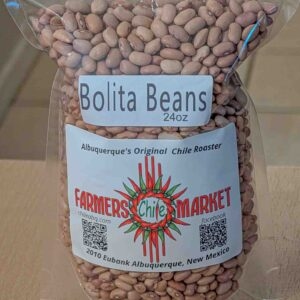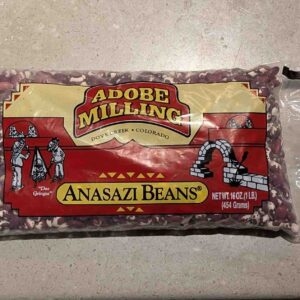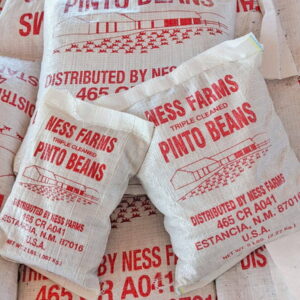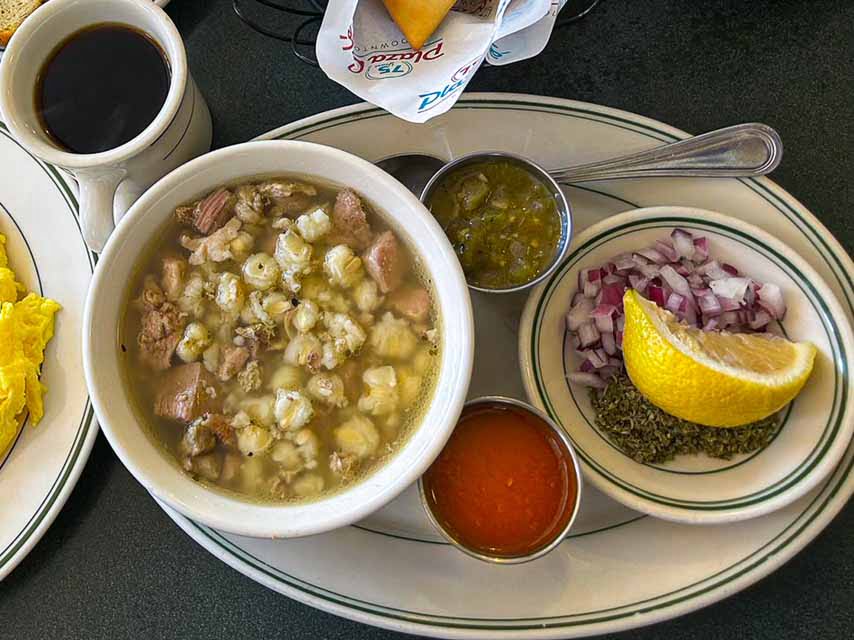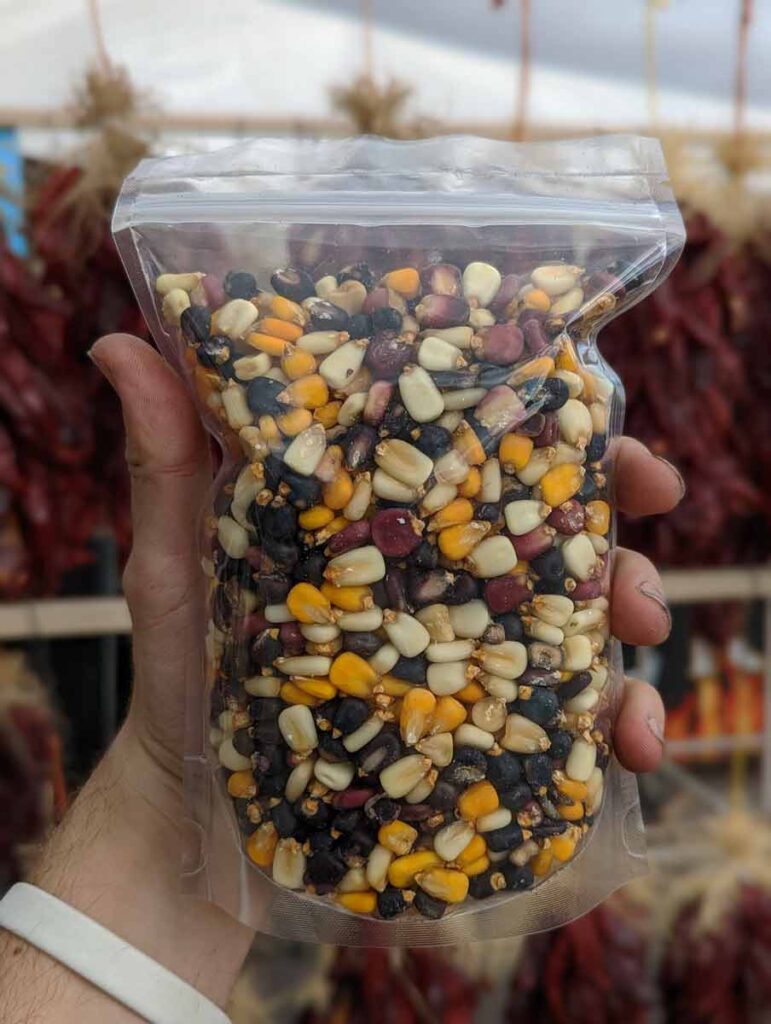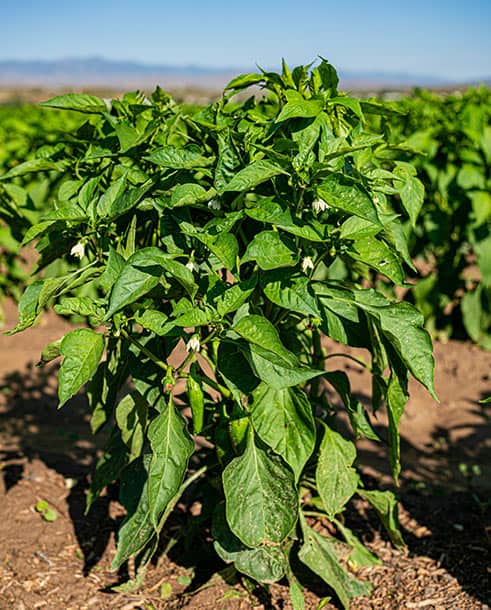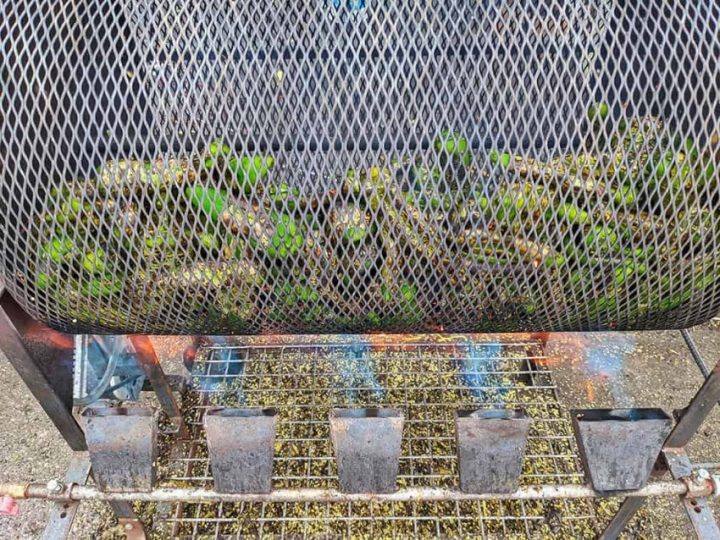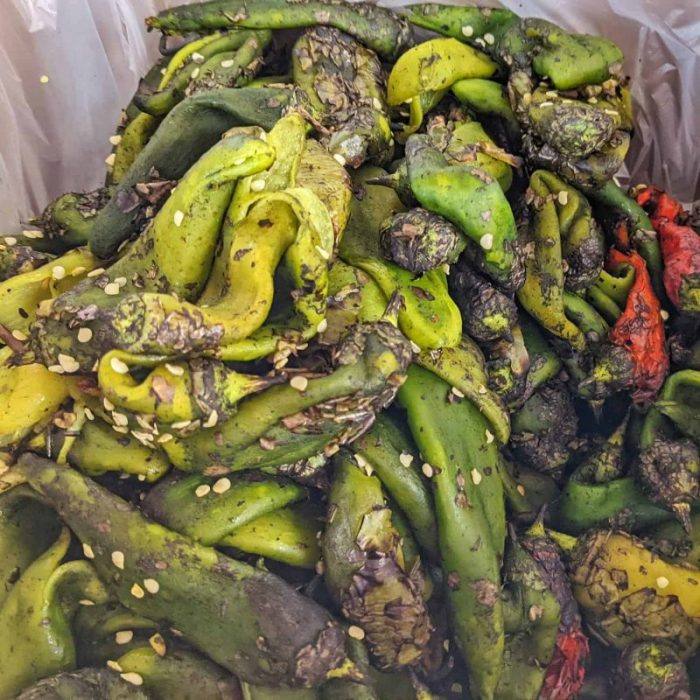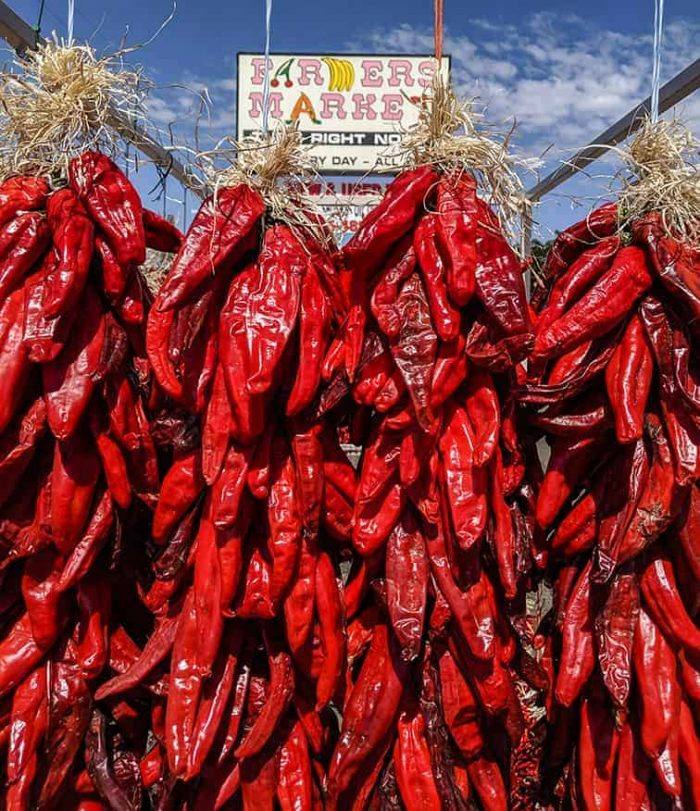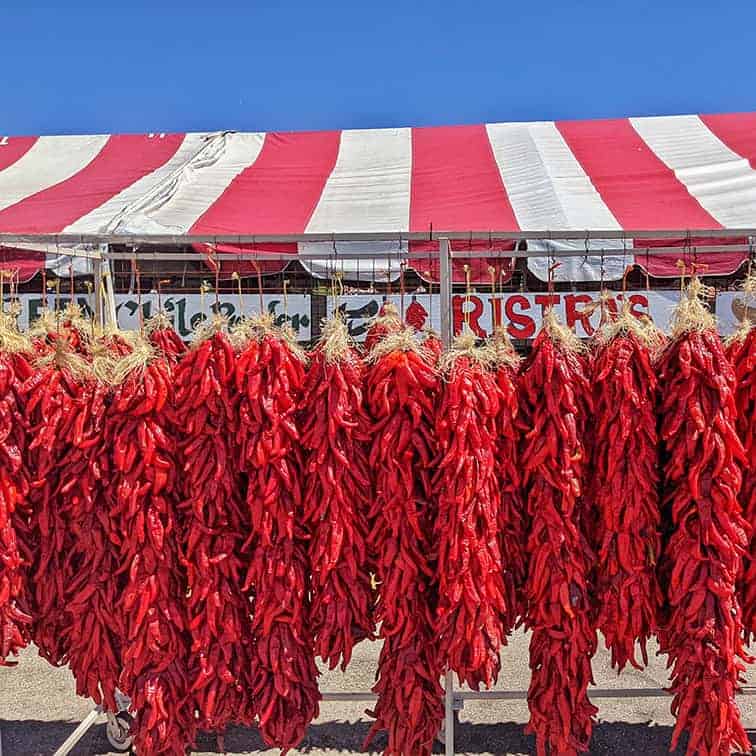Your cart is currently empty!
Month: March 2022
-
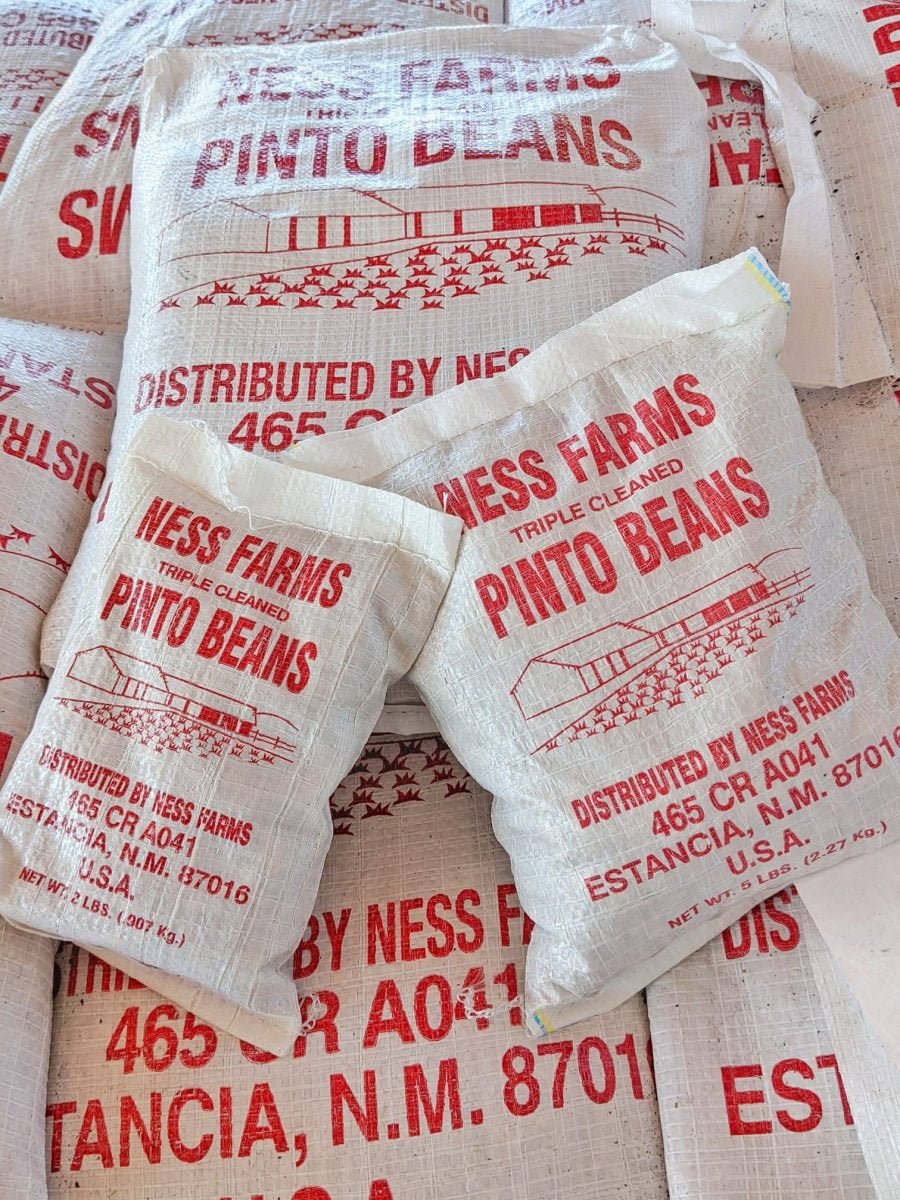
Local Estancia Pinto Beans
When it comes to local beans, we have tried many different farms since we started in 1962. There are bean growing regions in many areas of New Mexico, but our go to place in the last 20 years has been Ness Farms. They take pride in having only the best quality beans available. Every year, when they new crop of beans comes in, they buy back old product in order to ensure the beans for sale in retail locations like ours are at most only one year old. The beans you might get at a typical grocery store will often be much older, sitting around in giant warehouses around the country for months or years, waiting for whatever giant company needs more supply.
This level of quality control is a big reason why we trust Ness Farms so much. Taking pride in one’s product is somewhat of a lost art it seems, with many corporations chasing fancy branding and efficiency over quality. Quality produce has always been our focus over our decades in business. We have always aimed to provide good quality at affordable prices for local New Mexicans like us. More than just that, we aim to support local farms and small businesses as much as we can.
Beans are an integral part of both Mexican and New Mexican cuisines, used as a side dish at almost every meal. With that importance, you better believe that we prioritize quality in this product. We aim to provide the most important ingredients of New Mexican food. Chile and beans is quite literally our bread and butter, the staple food and the flavor.
Where to get the best beans in New Mexico
During the chile season, we have Ness Farms beans at 2010 Eubank NE 87112 in Albuquerque. We are open every year from August to the end of October, and also get our pumpkins from the same farm. In addition to beans and pumpkins, we also have many Hatch red chile ristras, and a large variety of green and red chile products, not to mention lots of local produce as well.
-
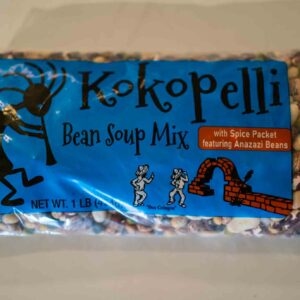 Kokopellli Bean Soup Mix – 1 lb$6.99
Kokopellli Bean Soup Mix – 1 lb$6.99 -
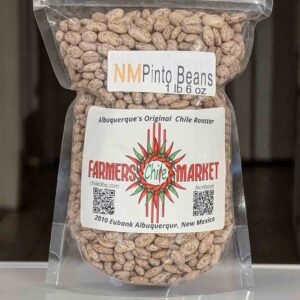 1lb 6 oz Estancia, NM Pinto Beans$6.99
1lb 6 oz Estancia, NM Pinto Beans$6.99 -
 Bolita Beans$9.99
Bolita Beans$9.99 -
 Anasazi Beans$7.00 – $27.00
Anasazi Beans$7.00 – $27.00 -
 25 Lb Estancia, NM Pinto Beans$58.00
25 Lb Estancia, NM Pinto Beans$58.00
-
-

What is Posole
Posole, a nixtamalized corn dish, has been a staple food in Mesoamerica for centuries, evolving into diverse and delicious regional variations across Mexico. Beyond the rich history of the dish itself, each variation carries further regional influences, local flavors, and cultural connections.
If you are in New Mexico or old Mexico, you will no doubt see posole on many menus, especially if the weather is cold. Also spelled pozole, the name doubles as an ingredient and a soup. The ingredient itself is a nixtamalized corn, similar to hominy. As we aren’t a restaurant, we focus mainly on the dried form of posole. It is a fantastic ingredient in soups, but can also be used in salads, or ground up to make corn tortillas. It is a truly versatile ingredient, which is healthy and filling.
Other corn products in NM
Corn products have long been a very important part of New Mexican cuisine, and posole or hominy is just one aspect of corn in New Mexican food. Chicos del horno is another very popular corn ingredient we use They kick up the flavor in a bowl of beans to another level! Keep in mind that chicos take much longer to cook than dried pozole, so start cooking chicos at least an hour before you add the posole kernels in!
Posole the soup
The soup has many different varieties in Mexico, with soup colors ranging from green, to red, to even black, often incorporating chicken or pork. In New Mexico, the typical soup is made with red chile and pork, often accompanied by a tortilla. This hearty soup is full of nutrition, as the process to turn corn into posole unlocks a lot of vitamins and minerals from corn that we are unable to digest normally. More than just being healthy, the soup warms one’s bones on cold winter days. If you ever travel to the balloon fiesta in the morning, be sure to try some posole and see how warm it keeps you.
Types of Pozole popular in Mexico
1. Red Posole (Pozole Rojo)
Vibrant and flavorful, red posole gets its bold color and spice from red chiles. Popular in the state of Guerrero and in New Mexico, the sauce is made with chiles like guajillo or ancho (or New Mexico’s hot Sandia or extra hot Barker chiles). This base simmers with cooked hominy, tender pork, and a blend of spices. Garnishes like fresh shredded lettuce, radishes, avocado, and lime add vibrancy to the hearty stew. Red chile pork posole is beloved in New Mexico, where it’s a common Christmas dish and a way to warm up during winter.
2. White Posole (Pozole Blanco)
A lighter take on posole, pozole blanco hails from Jalisco and Nayarit. The clear, flavorful broth features herbs like oregano and bay leaves. Hominy corn and meat (usually chicken or pork) are cooked until tender within. White posole is often served with toppings like diced onions, chopped cilantro, and lime wedges, allowing diners to customize the flavors.
3. Green Posole (Pozole Verde)
This variety is instantly recognizable by its vibrant green sauce, typically found in Guerrero and Michoacán states. The sauce is made by blending green chiles, tomatillos, cilantro, and garlic, leading to a fresh, tangy flavor. Tender meat, usually chicken or pork, and hominy corn round out this colorful variety. Garnishes like sliced radishes, avocado, and a squeeze of lime add extra brightness. Increasingly popular in New Mexico, green posole is sometimes made by blending green chile sauces with a traditional white posole base for a unique regional take.
4. Seafood Posole (Pozole de Mariscos)
Seafood lovers delight in this variation popular in coastal regions like Baja California and Sinaloa. Pozole de mariscos features a medley of fresh seafood like shrimp, fish, and clams. A combination of rich fish stock and tomato sauce creates a savory broth base, perfectly complementing the delicate seafood flavors. Garnishes like chopped cilantro, diced onions, and a squeeze of lime bring additional vibrancy.
5. Vegetarian Posole (Pozole Vegetariano)
This meatless option offers a delicious and satisfying twist on posole. Vegetarian posole is cooked in a vegetable broth seasoned with herbs and spices like cumin, paprika, and chili powder. Popular vegetables include carrots, bell peppers, zucchini, and onions. This hearty and nutritious dish might be finished with garnishes like avocado slices, chopped cilantro, and a sprinkle of queso fresco.
Posole in New Mexico
Red Chile Posole
New Mexico stands out with its ubiquitous red chile pork posole, by far the most popular regional variation within the state. For a vegetarian or vegan option, using a firm tofu, a few chunks of tempe, or a crumbly vegan meat substitute works really well in a bowl of pozole!
Green Chile Posole
Not to be outdone by its more mature rival, Red, green chile also works great in a posole. The trend towards green posole, sometimes prepared using a white base and blended with a green chile sauce, is increasing. Some regional restaurants even offer white posole with red and green sauces on the side, allowing for customization and a unique New Mexican experience. Naturally the same advice for vegetarian and vegan options works with green chile too!

A bowl of posole at the Santa Fe Plaza Cafe Health benefits of Pozole
Nixtamalization: Unlocking Nutritional Power
Nixtamalization is an ancient process of treating corn with an alkaline solution, traditionally made from wood ash or lime. This process has been fundamental to Mesoamerican cuisine for centuries. Far beyond enhancing flavor and texture, nixtamalization significantly increases the nutritional value of corn, offering several key benefits:
- Increased Bioavailability of Nutrients: Nixtamalized corn has enhanced bioavailability of essential vitamins and minerals:
- Niacin (Vitamin B3): Untreated corn is deficient in niacin. Nixtamalization releases bound niacin, making it available for absorption. This prevents pellagra, a disease caused by niacin deficiency.
- Calcium: Soaking in lime increases calcium absorption from corn, contributing to bone health.
- Other Nutrients: Nixtamalization also enhances the availability of iron, zinc, and other key nutrients.
- Improved Protein Quality: While corn protein is incomplete on its own, nixtamalization improves its balance of essential amino acids. This makes it a more valuable source of protein, especially when combined with other plant-based staples like beans.
- Reduced Mycotoxins: Corn can be susceptible to contamination by mycotoxins, harmful compounds produced by fungi. Nixtamalization partially degrades mycotoxins like fumonisins and aflatoxins, reducing potential health risks.
- Enhanced Fiber Content: Nixtamalization boosts the resistant starch content in corn. This type of starch acts as a dietary fiber, contributing to gut health, blood sugar regulation, and cholesterol management.
- Improved Digestion: The nixtamalization process softens the corn kernels and removes a portion of the outer hull. This makes nixtamalized corn easier to digest, benefiting individuals with sensitivities.
Health Implications
The nutritional improvements due to nixtamalization offer several potential health benefits:
- Stronger Bones: Increased calcium absorption contributes to bone health and may help reduce the risk of osteoporosis.
- Better Gut Health: Increased fiber intake aids digestion, promotes regularity, and fosters a healthy gut microbiome.
- Reduced Risk of Chronic Diseases: The combined benefits of improved nutrient balance, fiber content, and potential mycotoxin reduction may contribute to a lowered risk of chronic diseases like heart disease, diabetes, and certain types of cancer.
Incorporating Nixtamalized Corn into Your Diet
The most common way to enjoy the benefits of nixtamalized corn is through tortillas made from masa harina (nixtamalized corn flour). Other ways to include it in your diet are:
- Hominy AKA Posole: Whole nixtamalized corn kernels used in dishes like pozole or hearty stews.
- Tamales: Delicious bundles of nixtamalized corn dough called masa, often filled with meat or vegetables.
- Snacks: Corn chips made from nixtamalized corn can be a healthier option.
Important Considerations
While nixtamalized corn offers significant health advantages over untreated corn, it’s still important to maintain a balanced diet. Relying solely on corn, even its nixtamalized form, will not provide all essential nutrients. Pair nixtamalized corn with a variety of fruits, vegetables, beans, and other whole foods for optimal health benefits. Remember that we at Farmers Chile Market sell plenty of healthy food products, but we are not medical professionals. Be sure to consult with a qualified doctor for medical advice.
Nixtamalization is a stunning example of how traditional food preparation techniques contribute to both deliciousness and nutritional value. Whether you spell it posole, pozole, or hominy, the process to make it results in something that is great in terms of flavor, texture, and healthiness.
Posole at Farmers Chile Market
At Farmers Chile Market, we do our best to provide local options, and New Mexican posole is one of them. Whether you like yellow corn, blue corn, or even mixed color varieties, we will almost always have locally sourced posole available. We are a company that has supported local farmers and small businesses since 1962. Since our change to being a seasonal business, we have increased our proportion of local products. Chile season is also when many other fruits and vegetables are in season in New Mexico. We always aim to get produce as fresh as possible. Buying local means we get it the day after harvest.
If you are buying posole, you should also remember to pick up a chile ristra, or dried red chile pods too. They go hand in hand, and with these ingredients and posole, you can cook a large amount of New Mexican recipes. In case you are looking for a recipe for red chile to make a bowl of posole with, be sure to check out our red chile sauce guide. On that note, I have written a whole section of our website dedicated to how to cook different New Mexican dishes, be sure to check out our recipes section!

Where to get posole in Albuquerque
During the chile season, Farmers Chile Market has several varieties of posole at 2010 Eubank Blvd NE 87112 in Albuquerque. When we say posole or pozole, please note we are talking about hominy, not the dish which shares the name. We are open every year from the first weekend of August until Christmas. We have many other local products from farms around New Mexico as well. Roasting green chile is still our core business, but we aren’t just a one trick pony. Come see for yourself why we are the best source for New Mexican food products in Albuquerque. Check our webshop to see why we are a great source for New Mexican ingredients shipped to your door too!
-

It’s time to grow New Mexico chile
It is March 2024 now, and the weather in New Mexico now is quite cold, but it will probably be the last real winter weather of the season. That means it is almost time to plant chile! If you want to plant indoors and transfer later, you can do it from the beginning of March, then transplant them outside after 4-8 weeks. Chile doesn’t really like ground temperatures less than about 60 degrees at night, so keep that in mind.
If you want to buy seeds, the Chile Pepper Institute in Las Cruces, New Mexico is my recommendation. They are a part of New Mexico State University, which is responsible for cultivating the New Mexico chile varieties we all know and love. The proceeds from sales go directly into research and education related to chile cultivation. They also have plenty of information available online about how to grow chile, whether it is conventional or organic, and in New Mexico or elsewhere.
There are many guides online which do a great job explaining how to grow, so I won’t waste your time writing one. Check here for a great guide written by Paul Bosland, director of the Chile Pepper Institute and Stephanie Walker. Additionally, check here if you want my guide to growing chile. It covers many things about growing chile, and helps break down common problems so you can get the best possible plant growth and fruiting.
If you happen to grow a large amount and want it roasted, we can do that at 2010 Eubank in Albuquerque for a small fee. We hope to be your source for chile roasting in Albuquerque in 2024! Naturally, we also have tons of chile ristras, dried chile products, and a lot of local produce too!

Hatch Green Chile roasting in Abluquerque -

Hatch Chile Roasting Near you in 2022

Hatch Green Chile roasting in Abluquerque Where to get roasted green chile
When it comes to roasted Hatch green chile in Albuquerque, the original is always worth checking out. We’ve been roasting chile since 1977, before anyone else in the city. Most other roasters were just kids or not born born yet back then. Our address is 2010 Eubank, and we open every day from 9-5 during the months of August, September, and October.
Check out our post for Hatch chile roasting in 2024 here! For the 2024 chile season, we will begin roasting on Friday August 2nd, 2024.
Check out our post for for Hatch chile roasting in 2023 too! We started roasting on Friday August 4th for the 2023 green chile season.
Every chile season, New Mexicans always consider where to get their Hatch chile roasted. Many people here prefer chile from other areas, such as Lemitar, San Antonio, or Chimayo. In the early season, we always start our green chile roasting with Hatch chile. Simply put, it is ready faster. As the plants get older however, the chile they produce becomes smaller and doesn’t roast as well. In this case, it is best to let the chile turn red and mature.
Because the Hatch season is earlier, we change over to our farmers farther north later in the season in order to get the best quality chile available at the time. If the month is August, our green chile is almost certainly Hatch green chile. If it is around September or later, our green chile will likely be from Snake Ranch or another farm in the Socorro Valley area. There are many places here growing fantastic New Mexico chile.
Regardless of whether you are looking for Hatch chile, Lemitar chile, or somewhere else, we are confident that our chile quality is just as good, if not better. Our farmers use seeds bred primarily for flavor rather than yield per acre as a lot of “Hatch chile farms” use. If you want good quality roasted green or red chile, you can be sure to get it here. We pride ourselves on being a great chile roaster in Albuquerque.
If you are asking yourself “where to get chile roasting near me in 2022,” You can find your solution in the Northeast Heights at 2010 Eubank. We will also have plenty of red chile ristras, other chile products, and local produce available.
More info about New Mexico Chile
Check out our guide to roasting chile at home.
If you know anyone who will be roasting chile as a professional, our guide to roasting with a barrel roaster will be a great read for them.
Check here if you are curious about different varieties of chile.
Also, feel free to read through our blog if you want to learn other things about New Mexico Chile. We add new content regularly, and will feature recipes along with other knowledge and opinions as the traditions of the chile industry change. It is a very different game than it used to be, with many new varieties available. We hope you enjoyed reading our blog, and hope to see you when you are looking for roasted green chile in 2022, 2023, 2024, and beyond.
-

Chile Ristras are food
Upon traveling to New Mexico, one of the first things someone will notice is chile ristras. The eye catching strings of dried or drying red chile are quite appealing to anyone who likes the southwestern aesthetic. Throughout New Mexico, the red of chile ristras, and the green from green chile are everywhere, even more than the color turquoise in Santa Fe.
Something unfortunate in my opinion, is that for many, chile ristras are seen as only a decoration. Yes, they are beautiful, but they are also wonderful for cooking with, and keep a great flavor for up to 3 years. Typical red chile ristras are made with sandia chile, which is hot, but not too hot. It is a variety which is spicy enough for someone who likes heat, but won’t cause undue pain on a spice novice. Additionally, the natural drying process that the chile goes through gives it a deep somewhat savory flavor due to the fermentation which takes place during drying.
More than just flavor, red chile sauces are incredibly easy to make. All one needs to do is take out the stem and seeds from chile on the ristra, blend it up for about 10 minutes with some garlic powder and onion powder, then boil it with a chicken or vegetable stock. Altogether, the whole process takes less than an hour, and you can make a red chile sauce which will last a year or more in the freezer. For more ideas about what to cook with your chile, check out our recipes section!
The best part about all of this, is that it is quite easy to harvest chile from the bottom of your ristra, then push the string up into the remaining chile to hide it. The ristra gets shorter as you use it, but it still stays quite beautiful. This kind of two way decoration is very good for sustainability as well as being beautiful and delicious. Ristras are a great blessing, and we are very proud to sell 100% edible ristras in Albuquerque at 2010 Eubank. As always, we aim to be the best place for roasted chile in Albuquerque!
If you are curious about ristras, you can learn more in our FAQ
-

New Mexico should grow chile in public spaces
I have been traveling in Mexico for the past month in order to practice Spanish, in addition to learning more about chile. Something I have found while here is that agave is used as a decoration everywhere, especially in the state of Jalisco. In the median for roads, on the side of the road, in parks, and everywhere else you can think of, agave are planted by the local government.
These agave are not for harvest, but simply for decoration. That being said, it does a great job for branding. One can’t visit there without thinking about tequila.
In New Mexico, we have lots of ristras, chile pods, and chile roasters all around during chile season. Unfortunately, I don’t think I have ever seen a chile plant growing in a public space in Albuquerque. I don’t understand why something so important in our local culture doesn’t receive more attention from local governments. Chile is not very hard to grow, in fact I have grown it in several different countries with different climates. We already have parks with grass and other plants, so it shouldn’t be terribly hard to include chile in this as well.
Varieties of chile to grow
Naturally, I think that more mild varieties should be used, as children may eat the fruit of the plant if it is easily accessible. Still, the possible benefits to our community can be vast. It provides people a chance to see what kind of plant grows their favorite food. Many people don’t know much about chile, and can learn simply by seeing it. Additionally, chile plants will certainly be something tourists take pictures of. After all, chile is famous, and everyone who travels here knows that. If we provide more opportunities for people to show different aspects of our chile culture, more people will see and be interested in it.
New Mexico already has certain promotional sites such as New Mexico True, but having more visible chile plants will inspire more organic promotion of New Mexico and its chile tradition. Chile here is a real tangible aspect of society that we can show in its full form.
Chile’s Unifying Flavor
I believe that chile is one of the things that really unifies New Mexicans. If you are from here, whether you like Trump or Biden, or dislike both, you probably like chile. As long as you think New Mexican chile is superior to Colorado chile, we can all be friends. This aspect of our culture is one worth celebrating. It is one worth spreading. So now I ask, why don’t we grow more chile plants for decorative purposes?
When we open back up again on August 2nd, 2024, I will be sure to have some plants on hand in case anyone is curious how chile looks when it is growing. It is really quite enchanting watching the green chile turning to red.
-

New Mexico Chile Ristra FAQ
All about chile ristras
I get asked a lot of questions about chile ristras, ranging from “How long do ristras last?’ to “How to take care of a Hatch chile ristra?” This made me think that many people will probably be wondering about it online too. Because of that, I decided to make a quick FAQ with my answers and recommendations on it. If you have questions about the beautiful strings of dried New Mexico chile known as chile ristras, read on adventurer. In case you want to see a list of ristras we have for sale, click this link to jump down!
What is a ristra?In Spanish, ristra means string, but is also used to describe a string of chile peppers.
In English, pretty much the only way people use the term ristra is to talk about chile ristras, with a very small minority also using the term to talk about garlic bulb ristras!Why are ristras made?Originally, chile ristras were made only as a way to preserve chile, and keep it available as a food source in the cold winter. In modern times, food is less scarce, and most people make them as a decoration primarily. They still are a great source of food however, and we highly recommend cooking with chile from an older ristra when you get a new one!
How long do ristras last?The answer depends on many factors. An untreated ristra kept in good conditions will still look good after two years. A treated one might last 5 years or more. If it is kept in unfavorable conditions, it will break down sooner. One bad storm can destroy a ristra.
What is the best way to store a ristra?A ristra should be kept hanging, away from wind that will cause it to hit hard surfaces. The sun won’t damage sandia chiles as much as pequin, but will cause fading over time as well. If you want a ristra to last as long as possible, keep it in a cool, dry, and dark place without wind. If you want to display it outside, keep it in a partial sunlight area that is not windy.
Can chile ristras get wet?Although a small amount of water getting on a ristra probably won’t be a problem in a dry state like New Mexico, it should be avoided. Ristras which get wet can become a breeding ground for mold, which will eat the ristra from the inside out!
How spicy are ristras?The traditional New Mexican ristras are made with sandia chile, which is typically considered a “hot” chile. Pequin ristras however are much more spicy. If you want to cook with them, be very careful with the amount you use.
Are ristras edible?Every ristra that we sell at Farmers Chile Market is untreated, and therefore edible. Even if you have the chile after 2 or 3 years, it will still be delicious.
How to cook with ristras?Red chile sauces are incredibly easy to make. All one needs to do is take out the stem and seeds from chile on the ristra, blend it up for about 10 minutes with some garlic powder and onion powder, then boil it with a chicken or vegetable stock. Altogether, the whole process takes less than an hour, and you can make a red chile sauce which will last a year or more in the freezer.
How to use chile on ristra?Take the chile from the bottom of the ristra, then tuck the string up into the remaining chile. This lets you keep the ristra beautiful while also able to eat the delicious red chile from your ristra.
How to make chile ristras?It is a process of tying chile stems together with twine. Check our chile ristras page for a more detailed guide on making a ristra!
What chile are ristras made with?Most ristras in New Mexico are made with sandia chile, though many special shaped ristras are made with chile pequin, also known as chile de arbol as well.
How many Scovilles is a ristra pepper?In case the ristra is using a large Sandia chile pepper, it will be around 6,000. Hot, but not super hot. If it is using small chile pequin, then it will be around 30,000, which is very hot, and will be too spicy for most people, even in New Mexico!
How can I travel with a ristra?If you want to travel with a ristra, it is best to get one that is not totally fresh, but also not completely dry. This is because fresh ristras might rot, and dry ristras are more prone to breakage. Second, it is best not to lay it down for too long, as the ristra may become deformed. If you can rotate it, this problem will be less serious. If you are taking it on an airplane, I recommend wrapping it in something breathable and soft, so it can’t be jostled around too easily, and still has some ability for airflow. When driving, I recommend hanging it on a hook, provided it does not bang against the windows. If you don’t have hooks, I recommend just laying it flat as straight as possible, and gently turn it daily to prevent it becoming deformed.
Where are your ristras from?All our ristras come from the sunny Hatch Valley, in southern New Mexico.
Where is the best place to get chile ristras in Albuquerque?Farmers Chile Market at 2010 Eubank Blvd NE 87112. We get fresh chile ristras in around the start of September every year, and continue selling ristras until Christmas every year.
Why don’t ristras use green chile?Most green chile varieties turn to a yellowish brown color when they dry. In some multicolored ristras, this is not bad, as it provides more color variety. That being said, it looks unappealing compared to red chile ristras.
When are ristras available?Generally ristras are available once Hatch chile has had a time to mature and turn red. This typically happens about a month after chile season begins. New Mexico becomes usually awash in fresh ristras around the start of September.
Are ristras seasonal?Fresh ristras are a seasonal item in New Mexico, with the majority being tied in the months of September and October. Because they are sun dried, they are shelf stable at room temperature, and can be obtained at any time, but they won’t be bright and fresh like the ones you can get during the chile season.
Where do you hang ristras?Hang them in a place which isn’t too windy, so the chile doesn’t get damaged. Partial sunlight is best to avoid fading, but red chile ristras kept in the sun will still continue looking good for a long time. We also have a more detailed answer in our post Where to hang a chile ristra?
Can you eat chile ristras?You can eat Farmers Chile Market ristras once they are dry. Some sellers will treat the ristras with inedible materials to make them look fresh for longer.
What kind of chile is in ristras?Typically ristras are made with large sandia chile pods, a hot New Mexico chile which dries very well. If the chile is small, it is likely chile pequin, also known as chile de arbol in old Mexico.
How long do red chile pods last?If they are stored well, with cool temperatures and low humidity, chile pods keep a good flavor for a few years.
Do you ship chile ristras?We will begin shipping chile ristras in mid-September this 2024 chile season. We have a list of different options for chile ristras on the bottom of our Chile Ristras page.
When are fresh red chile ristras ready?Once the chile has had enough time to ripen to red, chile ristras will arrive within days. When fresh chile ristras come in depends a lot on the chile season, as some years chie matures faster than others. That being said, they are typically ready by early September.
What is chile de ristra flavor?Chile de ristra flavor depends on what kind of chile the ristra is made of. A typical large pepper Hatch chile ristra is made with Sandia chile, which is a hot variety. The types of ristras using smaller chile are typically made with chile de arbol, also commonly called chile pequin in New Mexico. This chile is much hotter, and should be used with caution, as the spice can easily overwhelm most people.
What types of ristras do you sell?We have a really wide variety of ristras, ranging from a few inches to 5 feet long. We also sell different shapes, colors, and chile varieties too! Check out our list of ristras below for more information!
Ristras for Sale

